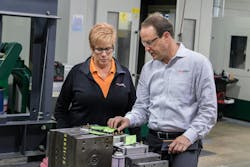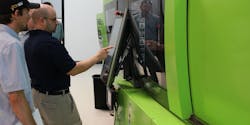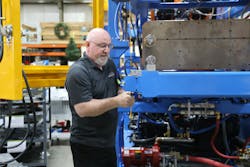Mergers, acquisitions provide off-ramp for departing plastics business owners
What you'll learn:
-
M&A activity in plastics has fluctuated in recent years. Despite tight lending conditions and industry challenges (e.g., inflation, tariffs), private equity funds remain active.
-
Aging business owners (especially baby boomers) are seeking exits, their successors often lack interest or capability, and emotional ties can complicate the decision.
-
Successful deals can lead to growth, investment in the business and renewed energy.
-
Owners should begin planning for a sale 3 to 5 years in advance, improving financials, diversifying customers, enhancing management teams, and investing in equipment and ERP systems.
- Sellers care about preserving company culture and protecting employees and customer relationships, so finding the right buyer who aligns with these values is crucial.
By Karen Hanna
The thermoforming officials had no idea what they were getting into. After walking a molding shop for about 30 minutes, they decided to take the plunge — buy the shop and become molders.
It was a bad idea.
At least that’s the take of molding consultant Umberto Catignani, who said he was called as an expert witness once buyer’s remorse set in for a group of investors who bought a shop they later claimed was a bill of goods.
Whether a buyer or a seller, it’s best to do your due diligence when it comes to mergers and acquisitions (M&A). Experts say the market’s a little shaky, but with many plastics processing company owners nearing retirement, there are investment opportunities.
Just be sure you look before you leap — and retain the services of someone who’s experienced with shepherding the M&A process: “The smartest thing to do,” Catignani said, “is realize you’re not that smart, or you’re not the smartest guy in the room. Acknowledge that, and hire people that are smarter than you.”
Deal me in
R.L. Hulett Managing Director Trevor Hulett has overseen plenty of deals during his time at the middle-market investment banking firm, which has helped with hundreds of transactions through its M&A advisory services.
Hulett’s plastics-transactions business feels the impact of the same kinds of factors plant owners themselves are experiencing: a tight labor market, tariffs, inflation, concern about environmental sustainability, resin price volatility. But those challenges haven’t stopped investment in the plastics industry.
“We’ve seen tightened capital markets in terms of lending and access to working capital and CapEx (capital expenditure) spend and that sort of thing has tightened up, or has been running tighter over the last few years. Conversely, we’ve seen private equity funds that have raised, surprisingly, a lot of capital in that same period, and are very actively looking for new platforms.”
Over about the last year, high-profile deals have included Hillenbrand’s sale of a 51 percent ownership stake in Milacron to an affiliate of Bain Capital for $287 million; the mergers of Amcor plc with Berry Global Group Inc. and Novolex with Pactiv Evergreen Inc., completed in April; Myers Industries Inc.’s acquisition of Signature Systems; and the Blackford Capital private equity firm’s acquisition of Industrial Molding Corp. as the first add-on acquisition for its portfolio company, Davalor Mold Co. LLC.
Deal activity tends to come in waves, observed Steven Rocheleau, the president and one of three owners of blow molding machinery maker Rocheleau Tool & Die, which in almost 100 years of family-owned operation has seen many companies come and go.
“We’ve been doing it long enough to see those peaks and valleys, that there’ll be a time where it seems like companies are buying up all the small people. There’s some efficiencies with that,” he said. “And then, invariably, some of the customers and the brand owners that are buying bottles or packaging get nervous that now their supply chain is focused on only one supplier, and they’re like, ‘Oh, we don’t want to be ... completely tied into just one person.’ So, then you’ll see new opportunities come up with either new companies or people bringing some of their own capacity in-house.”
According to a report released by R.L. Hulett, M&A deal volume within plastics declined 7.8 percent from the fourth quarter of 2024 to the first quarter of 2025, from 129 deals to 119. But the number of deals represented an increase of 5.5 percent over the 103 deals that closed over the same period last year.
However, a report by Corporate Finance Associates (CFA), which for 60 years has advocated on behalf of business owners who are restructuring a company, found across-the-board declines: Specifically, there were 61 transactions in the first quarter of this year, compared with 104 deals to end 2024. The volume of both large and smaller deals declined — from nine above $100 million in the last quarter of last year to eight in the first quarter of this year, and from 93 sub-$50 million deals in the fourth quarter of last year to 52 in this year’s first quarter.
Meanwhile, the “Plastics Industry Annual Update 2024,” issued by Stout Risius Ross, a global advisory firm specializing in corporate finance, accounting and transaction advisory, valuation, financial disputes, claims and investigations, stated there were “347 plastics industry M&A transactions in 2024, essentially flat from 2023 and still lower than historical averages.”
Due to the Trump administration’s platform emphasizing support for domestic manufacturing, Stout anticipated deal-making momentum: “M&A activity in the industrial end market has persisted, completing 54 transactions in Q4 2024 with anticipated acceleration in 2025 as company performance continues to stabilize with potential stimulus to domestic manufacturing from the new administration.”
But that’s not what Laurie Harbour, a principal at the Wipfli audit, tax and advisory firm, was seeing in early May.
While she’s expecting the next five years to be fairly active, she said, “Everybody is just really slow.”
Maximizing potential
Harbour knows firsthand what the M&A experience feels like from both sides of the table — last year, she sold Harbour Results Inc., the consulting firm her father started, to the company where she currently works. While she’s proud of her work at her family’s firm, she said she has no regrets.
According to her and other people familiar with M&A activity, a sale can infuse fresh energy.
“It’s a very emotional decision because it’s the baby you created, or you’re the fourth or fifth generation, and your grandfather, your great-grandfather started the business. Then you’re thinking, ‘Wow, I’m selling granddaddy’s business,’ ” she said.
“Those people who do it and do it well and pick the new buyer well — because you get to pick who’s buying your business — they realize that it was the right decision. For us, it was absolutely the right decision, and the opportunities are even better. Sometimes, we as owners hold our own business back a little bit because of our legacy thinking, and, if we can open up our mind and get the right buyer, then it takes some of the emotion out of it and allows for more growth.”
In a press release announcing a deal that Stout worked on — Viking Plastics’ sale last year to the Hoffmann Family (HF) of Companies — a custom molding plant executive commented on some of the benefits of the merger. “We are excited to join HF Companies,” said Kelly Goodsel, president and CEO of Viking Plastics at the time of its sale in August. “This acquisition positions us for the next phase of our growth, and we eagerly anticipate both continued success and strengthening relationships with our exceptional clients.”
Hulett noted that an owner’s exit doesn’t mean the end of the road for the business. With the right buyer, the future can be even brighter.
Beyond their own financial benefits, prospective sellers usually are interested in what kind of culture a new ownership group might bring, as well as the investments it might make. They’re concerned for their workforce, legacy and customers.
“Without a doubt, typically, they’re looking for a buyer or partner that brings more to the table than just the capital, and they’re looking for a good buyer that will continue the legacy where the culture is compatible,” Hulett said. “They want to feel good about leaving the keys and the legacy with the employees and customers.”
With an infusion of cash, companies can make investments to become more competitive, Harbour said. They can consolidate to better position themselves to invest in equipment or technology, or access new or adjacent markets or verticals.
For some struggling companies, an offer from a bigger company might even provide a lifeline.
Because of benefits of scale and the advantages of seeing things from a new perspective, a new buyer can make an immediate impact at a company — and maybe bring improvements.
For some sellers, that’s an important consideration.
It’s a “good opportunity for growth ... to be able to offer more products, or bring value to the table for their customers and their employees in terms of career advancement and being able to be challenged with new and different types of projects and production and capabilities and processes and that sort of thing. ... What does the buyer bring to the table that can help the company grow?” Hulett asked.
“If it’s a founder-owned or family-owned company, it’s a challenging business to be competitive with the bigger players. And, so, typically, there’s some holes in the management team structure, that companies of that size maybe can’t afford to have a whole complement of high-paid C-suite-level people. And, so, there’s some resources in terms of sales and marketing and access to end markets and distribution channels, and perhaps logistics and warehouses and manufacturing capacity, access to raw materials that can help drive pricing down, all of those things that a buyer can bring to the table to help the company grow and become more profitable.”
The right deal can be a win-win.
With locations in Pennsylvania, Indiana and Kentucky, Viking Plastics makes parts for the automotive, HVAC and industrial markets.
Both it and HF said the acquisition made them better.
“The acquisition of Viking Plastics represents a strengthening of Hoffmann’s portfolio of manufacturing businesses, with an emphasis on U.S. manufacturing,” states the report released by Stout, which served as exclusive financial adviser to Viking and the group of companies that formerly owned it, Spell Capital Partners.
Cashing out
Prominent among partners for these deals are heads of family businesses who want to retire, Hulett said. For a maturing industry, like plastics, which truly took off in the second half of the last century, that means the time is now for a lot of people. According to the figures posted by the U.S. Bureau of Labor Statistics in January, more than one-quarter of people in the industry are 55 or older.
“More and more, we’re seeing trends of the next generation just really aren’t interested in injection molding or thermoforming; they’re more interested in the service industry,” said Hulett, who noted typical sellers are founder-owners in their 50s and 60s who have built the business over the past couple decades. “We’re just seeing more and more of the [baby] boomer generation aging out with the next generation [not] in the business. And, so, they need to find a path to exit. It’s harder and harder to compete with the bigger players. There’s margin pressure. The tariff situation isn’t helping. But I do see where there will continue to be consolidation, and there’s been a proliferation of private equity capital that’s been raised.”
Leaving becomes complicated when there’s no one in the wings to take over. Often, founders and owners realize there’s no interest or aptitude in a subsequent generation that might carry on their business’ legacy.
Relying on the next generation can be a mistake, observed Catignani, who has visited scores of plants over the years as president of Orbital Plastics Consulting. He said he has met sons and daughters who aren’t up for the job.
“What I have seen in general through the years is that the father starts the business, or the family starts the business, and it takes 20, 30 years to get it to some kind of level where maybe there’s 10 machines or 20, and then the son or the daughter is going to take over perhaps, and they run it completely into the ground, because they don’t know anything about molding,” Catignani said.
Where the interest is
M&A activity within plastics processing tends to concentrate in certain segments.
Harbour noted the plastics industry includes thousands of processing shops with under $100 million in revenue; many of them are family-run.
Those are prime targets for M&A activity.
“I would say anybody [between] 50 to 100 million [dollars], those are a lot of the people that are primed for rollup in acquisition by a private equity or a strategic buyer ... like a billion-dollar company,” she said.
The Hulett report says North America was the most active region in the first quarter of this year with 51 deals. The CFA report predicts North America will continue to outpace Europe, as businesses continue to strengthen their own position by investing in other, complementary businesses.
According to the CFA report, Harbour and Stout, deal activity has been especially strong in injection molding.
“The medical segment had its most active year since 2021 with peer-leading transaction multiples,” the Stout report states. “Additionally, automotive M&A activity posted a five-year high in 2024, supported by international strategic acquirors. Packaging M&A activity has continued to tighten, specifically within the middle market, as streaky consumer demand created uncertainty for acquirors and sellers alike.”
Harbour’s view of the most popular and least popular markets differs from the Stout report. She said companies that make packaging, especially medical packaging, are drawing interest.
“Medical is still a very good place to be. ... Anything that’s really inflation-driven, a business that’s making products for [the] power sports or automotive [markets] right now, it’s probably not high on anybody’s list.”
Of special interest, Hulett said, are companies that are pursuing environmentally friendlier strategies.
“I’ve seen a lot of interest in innovation and sciences around sustainable, like the new environmentally friendly raw materials, resin mixes and compounds that are becoming more environmentally friendly. And that’s a huge element to attracting private equity,” he said.
Building curb appeal
For owners looking for the exits, there are ways to improve the bottom line. Just as homeowners spruce up their properties with new landscaping or a kitchen makeover before selling, company owners can polish their M&A appeal, with steps that could include developing new markets, getting their financials in order and enhancing the credentials of the team they employ.
Hulett said owners typically should start making preparations at least a few years to five years out.
“A lot of entrepreneurs that buy businesses, they get in and begin with the end in mind. That’s private equity: They’re thinking about the exit, even before they buy the plant,” Hulett said. “So, be thinking about your exit and what you can do. Start early, start now. What can you do to position a company for an exit? Talk to a professional to help, at least give you some feedback on ‘What are buyers looking for? What are buyers willing to pay for?’ ”
Company earnings before interest, taxes, depreciation and amortization (EBITDA) are an important factor — though not the only one — in setting an asking price.
For Hulett, one of the first steps is setting expectations. Some clients are more reasonable than others.
"Some are more flexible and open-minded than others, but some are just pounding the table, adamant, like, ‘My buddy at the country club got 11 times EBITDA for his business. So I’m just not going to sell for anything less than 11 times EBITDA for this business,’ ” Hulett said. “It’s like, ‘We’ll do our best here. But I’ve got to tell you, I don’t think you’re worth 11 times EBITDA, but ... you never know, until you go to market.”
Hulett and Harbour said one way businesses can burnish their value is by adding to their customer portfolio or working to diversify the markets they serve. This can mean that before they become sellers, business owners plotting their own exit might first become buyers.
In her experience with smaller companies, Harbour said she has seen how a strategic acquisition or two can better position a business for future deals.
“I would definitely say that some of the reason for acquiring a company would be to inject cash through private equity, or a different kind of investor, so that you could be able to add more equipment,” Harbour said. “I would definitely say we’ve seen people that have grown, acquired and then started replacing equipment and upgrading it. ... So, for example, let’s say you have a private equity firm that owns a $50 million molder and they buy a $20 million molder. They may be buying it because they need more capacity, they’ve got good sales, and they want to be able to take that and grow within another facility. So, they might upgrade the equipment, and they’ll have the people there already, so they don’t have to go hire a bunch of new people.”
Investors also are interested in businesses’ teams. Who’s staying? Who can help moving forward?
It’s a consideration for business owners who are planning their exit, too: With a deal on the line, they have the opportunity to provide for the future of their current workforce, Hulett said.
“The management team is important,” he said. “Where are the customer relationships vested? Do you have continuity of management that will enable you to exit, and will the buyer feel good about that transition with the management team? And then, contracts with customers is always good, having your key people locked down is good. Smoother or more documented processes on manufacturing and shipping and tracking orders and all those ... good, solid accounting and an ERP system tracking your metrics. ... Margin is important.”
Other strategies could include preparing detailed audits and financial review — a process that in itself might need a couple years of lead time.
“The more sophisticated you’re able to present revenue by customer, even revenue and gross margin by maybe product line or division or allocating your overhead, the more sophisticated, the better,” Hulett said.
Ready or not
Whether buying or selling, business owners and investors had better come prepared.
Having testified in legal disputes involving buyers and sellers unhappy with how the transaction played out, Catignani has seen what not to do. In some plants, the machines are “garbage,” and claims of actual performance can’t be substantiated. As the thermoforming officials’ experience illustrates, there’s a high price for not doing your homework.
“A lot of times what these guys do, with M&A, is that they cut maintenance. They don’t fix stuff. They don’t do that for several months, or whatever the term might be, to make the bottom line look much better. And, so, these guys come in, and they’re just dumping money into it to get machines running, and [machines] are down and they’re not making production.”
To help prospective buyers examine a shop, he said third-party experts can look at the condition of equipment, like dryers, molds and materials-handling units, and examine existing processes.
”There’s always going to be issues,” he said. “How bad are they?”
On the other side, Hulett said sellers, too, need help, though some don’t realize it.
“There’s a lot of thinking out there of owners that, ‘Why do I need an adviser? I could do this myself and save the commission.’ ... This may be the most important decision you make ever with the business that you’ve started and worked your tail off for 30 years to build, and you’re rolling the dice on that when you don’t know?”
For owners, leaving a company they’ve guided for years can be a fraught experience.
“We’ve seen sellers that get down the line and just can’t let go. They have seller’s remorse, and they end up pulling the plug. They don’t do the deal,” he said. “So, there’s some psychology-type of planning that can go into it, as well. That’s the toughest part.”
In addition to negotiating the best selling price, Hulett said, sellers should explore options to retain equity in their company.
“Many times, there’s an opportunity to roll equity and become part owners in that company which ... that second bite of the apple can be quite lucrative,” he said.
With a good financial guide, departing owners can be assured their business’ legacy will be safe even as they secure their own financial future.
Carrying on the legacy
But, whether you’re buying, selling or standing pat, there are opportunities amid M&A activity — as well as risks.
Over its decades as a machinery provider, Rocheleau Tool & Die has worked with all types.
According to Harbour, small manufacturers can make it — if they retain a focus on value and efficiency and avoid becoming complacent.
“If I’m running a really good, solid $30 million molder, and I’m profitable, and I have good customers, and I’m winning new work, I can survive for a very, very long period of time, slowly growing in my own space,” she said.
Unfortunately, Harbour said, many manufacturers within the plastics industry are barely getting by.
“In the tool [and] molds-building industry ... I have a handful of companies that I would say are top performers. They’re very profitable, they’re very efficient. They reduce lead time to meet the customers’ needs, and they’re doing very, very well. When those people compete against someone that’s just an average or poor-performing shop, they win the quote every time,” Harbour said. “I have mold builders who are pressured to be competitive and may go out of business, and we’ve lost several of them, because they weren’t good in their own operations, weren’t efficient enough in their own operations, to price more competitively.”
Regardless of the business’ corporate structure or size, for Rocheleau, success comes down to one thing — doing the right thing for every customer.
“We know that we need to be a trusted supplier for our customers, no matter how they became our customer, either direct or through acquisition. Holding each customer’s business important to them and how we supply them is critical for us, remaining that trustworthy partner in the industry. You never want to burn bridges, because you could end up through acquisition working with somebody again,” he said. ”So, we need to do the right thing every day.”
Contact:
Corporate Finance Associates, Aliso Viejo, Calif., 949-305-6710, www.cfaw.com
Orbital Plastics Consulting, Atlanta, 404-849-6714, www.orbitalplastics.com
R.L. Hulett & Co. Inc., St. Louis, 314-721-0607, https://rlhulett.com
Rocheleau Tool & Die Co. Inc., Fitchburg, Mass., 978-345-1723, www.rocheleautool.com
Stout Risius Ross, 833-204-0822, www.stout.com
Wipfli LLP, Southfield, Mich., 248.208.8860, www.wipfli.com
About the Author
Karen Hanna
Senior Staff Reporter
Senior Staff Reporter Karen Hanna covers injection molding, molds and tooling, processors, workforce and other topics, and writes features including In Other Words and Problem Solved for Plastics Machinery & Manufacturing, Plastics Recycling and The Journal of Blow Molding. She has more than 15 years of experience in daily and magazine journalism.




